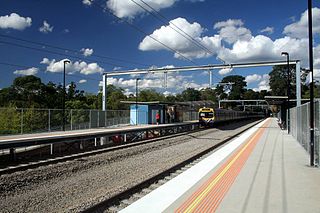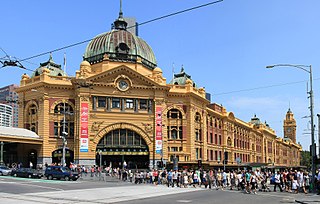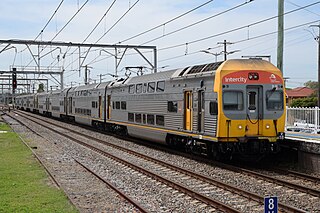
The T sets, also referred to as the Tangara trains, are a class of electric multiple units that currently operate on the Sydney Trains network. Built by A Goninan & Co, the sets entered service between 1988 and 1995, initially under the State Rail Authority and later CityRail. The T sets were built as "third-generation" trains for Sydney's rail fleet, coinciding with the final withdrawals of the "Red Rattler" sets from service in the late 1980s and early 1990s. The Tangaras were initially built as two classes; the long-distance G sets and the suburban T sets, before being merged after successive refurbishments.

Laburnum railway station is located on the Lilydale and Belgrave lines in Victoria, Australia. It serves the eastern Melbourne suburb of Blackburn, and it opened on 13 July 1958.

Burnley railway station is the junction station for the Lilydale, Belgrave, Alamein and Glen Waverley lines in Victoria, Australia. It serves the inner eastern Melbourne suburb of Burnley, and it opened on 1 May 1880 as Burnley Street. It was renamed Burnley on 1 September 1882.

Camberwell railway station is the junction station for the Lilydale, Belgrave and Alamein lines in Victoria, Australia. It serves the eastern Melbourne suburb of Camberwell, and it opened on 3 April 1882.

Ringwood railway station is the junction station for the Lilydale and Belgrave lines in Victoria, Australia. It serves the eastern Melbourne suburb of Ringwood, and it opened on 1 December 1882.

Belgrave railway station is the terminus of the suburban electrified Belgrave line in Victoria, Australia. It serves the eastern Melbourne suburb of Belgrave, and it opened on 18 December 1900 as Monbulk. It was renamed Belgrave on 21 November 1904.

The Lilydale railway line is a commuter railway line operating between Flinders Street in the Melbourne central business district and Lilydale through Melbourne's eastern suburbs including Richmond, Cremorne, Burnley, Hawthorn, Hawthorn East, Camberwell, Canterbury, Surrey Hills, Mont Albert, Box Hill, Blackburn, Nunawading, Mitcham, Ringwood, Ringwood East, Croydon, Mooroolbark, and Lilydale. It is part of the Melbourne rail network operated by Metro Trains Melbourne.

The Belgrave railway line is a commuter rail line operating between Flinders Street in the Melbourne central business district and Belgrave through Melbourne's eastern suburbs including Richmond, Cremorne, Burnley, Hawthorn, Hawthorn East, Camberwell, Canterbury, Surrey Hills, Mont Albert, Box Hill, Blackburn, Nunawading, Mitcham, Ringwood, Heathmont, Bayswater, Boronia, Ferntree Gully, Upper Ferntree Gully, Upwey, Tecoma and Belgrave. It is part of the Melbourne rail network, which is operated by Metro Trains Melbourne.
The Glen Waverley railway line is a suburban electric railway in Melbourne, Australia, operated by Metro Trains Melbourne. It branches from the Lilydale, Belgrave and Alamein lines at Burnley station. It has 12 stations in PTV ticketing zones 1 and 2.

The Melbourne rail network is a passenger and freight train system in the city of Melbourne, Victoria, Australia. It is the core of the larger Victorian railway network, with links to both intrastate and interstate systems. A large suburban passenger network centred on the CBD also operates, with a limited degree of segregation from longer-distance passenger and freight trains.

The Hitachi was an electric multiple unit that operated on the Melbourne suburban railway network between 1972 and 2014. Electrical equipment was supplied by Commonwealth Engineering to designs by Hitachi of Japan, leading to their official name today, though no actual Hitachi-supplied components were used in their construction. They were the last suburban trains in Melbourne with no air conditioning. A total of 355 carriages were built between 1972 and 1981, including a replacement carriage for one written off while the fleet was still being delivered.

The Comeng train is a type of electric multiple unit (EMU) that operates on the suburban railway network of Melbourne, Victoria, Australia. Built by Commonwealth Engineering (Comeng) in Dandenong, they were introduced in 1981 as a replacement for the Tait and Harris trains. In total, 570 carriages were built.

The S sets were a class of electric multiple units that operated on Sydney's suburban rail network from 1972 up until 2019. Originally entering service under the Public Transport Commission, the sets also operated under the State Rail Authority, CityRail and Sydney Trains. Prior to their retirement, the S sets were the last class in the Sydney Trains fleet to not be air-conditioned, earning them the nicknames "Tin cans" and "Sweat Sets". They were also nicknamed "Ridgys" because of their fluted ("ridged") stainless steel panelling; they shared this nickname with similar looking K sets and C sets. The final sets were withdrawn from service in June 2019.

The V sets are a class of electric multiple units currently operated by NSW TrainLink. Built by Comeng between 1970 and 1989, the sets are of stainless steel construction, and are currently the oldest in the NSW TrainLink fleet. Initially introduced under the Public Transport Commission, only sets from 1977 and onwards remain in service, now operating on Interurban services throughout New South Wales on the Main Western line to Lithgow and Main Northern line to Newcastle. The V sets will be gradually phased out with the introduction of the replacement D set trains
The Sydney Trains fleet serves the metropolitan lines within Sydney, Australia. All of the rolling stock are double-deck electric multiple units and operate mainly as eight carriage sets.
The railways of New South Wales, Australia, use a large variety of passenger and freight rolling stock. The first railway in Sydney was opened in 1855 between Sydney and Granville, now a suburb of Sydney but then a major agricultural centre. The railway formed the basis of the New South Wales Government Railways. Passenger and freight services were operated from the beginning. By 1880, there was a half hourly service to Homebush.

The Tait trains were a wooden bodied Electric Multiple Unit train that operated on the suburban railway network of Melbourne, Victoria, Australia. They were introduced in 1910 by the Victorian Railways as steam locomotive hauled cars, and converted to electric traction from 1919 when the Melbourne electrification project was underway. The trains derived their name from Sir Thomas James Tait, the chairman of commissioners of the Victorian Railways from 1903 to 1910. The first cars were built during 1909 with the last entering service in 1952.

Jolimont Yard was an array of railway lines and carriage sidings on the edge of the central business district of Melbourne, Australia. Located between Flinders Street station, Richmond Junction, the Yarra River and Flinders Street they were often criticised for cutting off the city from the river, being the site of many redevelopment proposals. The Princes Gate Towers were built over part of the yard in the 1960s, which themselves were replaced by Federation Square in the 1990s. The rail sidings themselves were progressively removed from the 1980s to the 1990s with only running lines today, but the area continues to be referred to as the 'Jolimont railyards' by Melburnians.

Metro Trains Melbourne, often known simply as Metro, is the franchise operator of the electrified suburban passenger service on the Melbourne rail network. Metro Trains Melbourne is a joint venture between MTR Corporation (60%), John Holland Group (20%) and UGL Rail (20%). The three constituent companies are also partners in the Metro Trains Sydney joint venture, which has operated the Sydney Metro network since 2019.





















